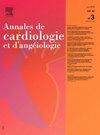左脑缺血性中风左心房缺血性中风左心房缺血性中风
IF 0.3
Q4 Medicine
引用次数: 0
摘要
寻找潜在的心脏源是缺血性中风(缺血性中风)紧急评估的基本步骤,缺血性中风的主要原因是房颤(房颤)。最近的研究证明,与左耳尺寸(OG)相比,用斑点跟踪法评估左心房功能作为发作性FA的预测器具有优势。OG菌株库(SR)的改变与CVA的发病率有关。方法对2022年1月至2023年4月在神经内科住院的患者进行回顾性观察性研究,研究对象为没有已知房颤或事先抗凝治疗的形成性或暂时性缺血性中风患者。本研究的目的是寻找1)SR与ICAD的象征起源之间的联系,并确定与ICAD相关的因素;2)之间有一个协会的SR和治疗房颤的发生与鉴别SR.RésultatsL’étude风化的相关因素,包括了79名患者(56%的男性,平均年龄72岁),有39%的AVCI cryptogéniques(其中26%),23% cardio-embolique过渡性和不明来源的emboliques (ESUS 14%)。在心脏栓塞病因(18例)中,33%为房颤继发,39为卵巢通孔(FOP)继发。中位SR为27%,86%的病例中SR为39%,无论左耳廓是否扩张。阈值为20%,P值为0.01,SR与CVID的栓塞起源有关(不包括FOP组)。20%的LR与随访中FA的发生有关(P= 0.04)。结论:我们的研究表明,在没有房颤史或抗凝治疗的患者中,急性ICD / ITD中20%的左耳膜紧张储层可能与房颤的栓塞起源和随访中房颤的发生有关。寻找潜在的心脏源是缺血性中风(IS)或暂时性缺血性发作(TIA)紧急评估的基本步骤。心肌梗死最常见的原因是心房纤颤(AF)。左心室功能的分析优于左心室(LA)尺寸测量作为发作性AF的预测,特别是在使用2D斑点跟踪研究畸形异常时。洛杉矶水库菌株(RS)的改变与IS的发病率有关。方法:对2022年1月至2023年4月在神经内科住院的无AF或抗凝治疗史的IS或TIA患者的回顾性观察研究。这项研究的目的是调查1)RS与IS的栓塞起源(心脏栓塞和ESUS)之间的联系,确定与IS相关的因素;2) RS与房颤发生之间的关联,识别与RS缺陷相关的因素20%。该研究包括79例患者(56%为男性,中位年龄72岁),39%的缺血性中风是隐源性的(其中26%是暂时性的),23%是心脏栓塞性的,14%是来源不明的栓塞性的。在心脏栓塞的原因(18例)中,33%为房颤继发,39%为卵巢专利孔(PFO)继发。无论左中庭是否扩张,86%的病例中,中位RS为27%,中位RS为39%。阈值为20%,P值为0.01,RS与脑卒中的栓塞起源有关(不包括全氟辛烷磺酸组)。随访期间,20%的RS与房颤的发生相关(P= 0.04)。ConclusionOur study suggests that a的水库体格of the left atrium < 20%的急性阶段during the of an ischemic她/ transient ischemic遭袭,病人in without a history of atrial房颤抗凝剂治疗,黄金may be associated with an embolic origin of the上了她的ischemic and the of atrial发生房颤during后续活动。本文章由计算机程序翻译,如有差异,请以英文原文为准。
Le Strain réservoir de l’oreillette gauche dans l’accident vasculaire cérébral ischémique The left atrial reservoir strain in ischemic stroke
Introduction
La recherche d’une source cardiaque potentielle est une étape fondamentale dans l’évaluation urgente d’un accident vasculaire cérébral ischémique (AVCI), dont la principale cause est la fibrillation atriale (FA). Des études récentes ont prouvé la supériorité de l’évaluation de la fonction atrial gauche par la méthode de Speckle-Tracking versus les dimensions de l’oreillette gauche (OG) comme prédicteur de FA paroxystique. L’altération du strain réservoir (SR) de l’OG est associée à l’incidence des AVCI.
Méthodes
Etude rétrospective, observationnelle chez des patients hospitalisés dans le service de neurologie, de janvier 2022 à avril 2023 pour accident vasculaire cérébral ischémique constitué ou transitoire, sans fibrillation atriale connue ni traitement anticoagulant préalable. Les objectifs de l’étude étaient la recherche 1) d’une association entre le SR et l’origine embolique de l’AVCI, avec identification des facteurs associés aux AVCI ; 2) d’une association entre le SR et la survenue de fibrillation atriale, avec identification des facteurs associés à l’altération du SR.
Résultats
L’étude a inclus 79 patients (56% d’hommes, âge médian 72 ans), 39% des AVCI étaient cryptogéniques (dont 26% sont transitoires), 23 % cardio-embolique et 14% emboliques d’origines indéterminées (ESUS). Parmi les causes cardio-embolique (18 patients), 33% étaient secondaires à une fibrillation atriale, 39 à un foramen ovale perméable (FOP). Le SR médian était de 27%, le SR était < 39% dans 86% des cas, que l’oreillette gauche soit dilatée ou non. Avec un seuil de 20% et une valeur de P à 0,01, le SR était associé à l’origine embolique de l’AVCI (groupe FOP exclu). Le SR < 20% était associé à la survenue de FA dans le suivi (P= 0,04).
Conclusion
Notre étude suggère qu’un strain réservoir de l’oreillette gauche < 20% à la phase aigue d’un AVCI/AIT, chez des patients sans antécédent de fibrillation atriale ni traitement anticoagulant, pourrait être associé à l’origine embolique de l’AVCI et à la survenue de fibrillation atriale dans le suivi.
Background
The search for a potential cardiac source is a fundamental step in the urgent evaluation of an ischaemic stroke (IS) or Transient ischemic attack (TIA). The most common cardioembolic cause of IS is atrial fibrillation (AF). Analysis of the left atrial function is superior to left atrial (LA) dimensions measurements as predictor of paroxysmal AF, especially with the study of deformation anomalies using 2D Speckle-Tracking. Alteration of the reservoir strain (RS) of the LA is associated with the incidence of IS.
Methods
Retrospective observational study in patients hospitalised in the neurology departement from January 2022 to April 2023, for IS or TIA, with no history of AF nor anticoagulation treatment. The objectives of the study were to investigate 1) an association between RS and the embolic origin (cardio-embolic and ESUS) of IS, identifying factors associated with IS; 2) an association between RS and the occurrence of atrial fibrillation, identifying factors associated with impaired RS < 20%.
Results
The study included 79 patients (56% men, median age 72 years), 39% of ischemic strokes were cryptogenic (of which 26% were transient), 23% were cardioembolic, and 14% were embolic of undetermined origin (ESUS). Among the cardioembolic causes (18 patients), 33% were secondary to atrial fibrillation, 39% to a patent foramen ovale (PFO). The median RS was 27%, and the RS was < 39% in 86% of cases, whether the left atrium was dilated or not. With a threshold of 20% and a P value of 0.01, the RS was associated with the embolic origin of the ischemic stroke (PFO group excluded). An RS < 20% was associated with the occurrence of atrial fibrillation during follow-up (P= 0.04).
Conclusion
Our study suggests that a reservoir strain of the left atrium < 20% during the acute phase of an ischemic stroke/transient ischemic attack, in patients without a history of atrial fibrillation or anticoagulant treatment, may be associated with an embolic origin of the ischemic stroke and the occurrence of atrial fibrillation during follow-up.
求助全文
通过发布文献求助,成功后即可免费获取论文全文。
去求助
来源期刊
CiteScore
0.60
自引率
0.00%
发文量
68
审稿时长
6-12 weeks
期刊介绍:
Organe scientifique de référence fondé en 1951, les Annales de cardiologie et d''angéiologie abordent tous les domaines qui intéressent quotidiennement les cardiologues et les angéiologues praticiens : neurologie et radiologie vasculaires, hémostase, diabétologie, médecine interne, épidémiologie et prévention.
Les Annales de cardiologie et d''angéiologie sont indexées aux grandes bases de données et publient rapidement, et en conformité avec les normes internationales de publication scientifique, des articles en français sur la pathologie cardiaque.

 求助内容:
求助内容: 应助结果提醒方式:
应助结果提醒方式:


